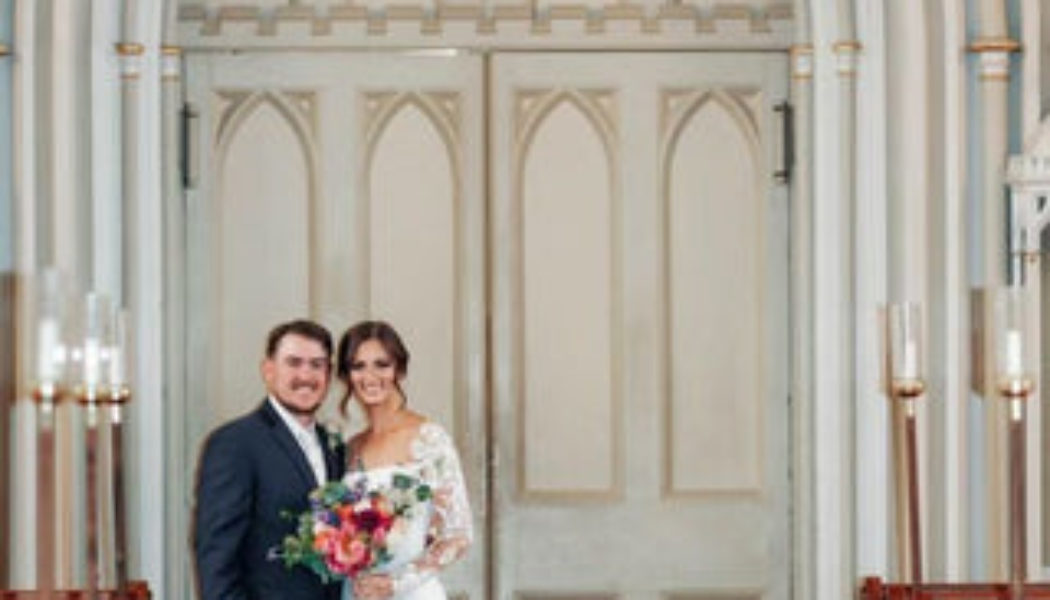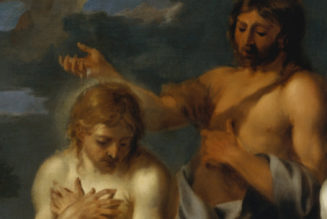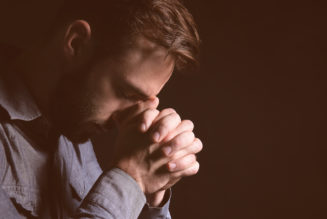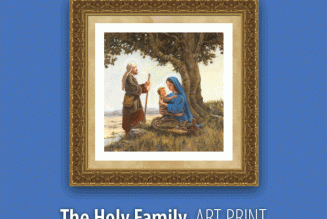By Emily Malloy
Weddings and flowers have become synonymous over the ages. What is it that marries these two together (pun intended)?
Throughout history, flowers have played a major role in weddings (most notably bridal bouquets) primarily to mask odor. As hygienic practices have improved over the ages, the role of flowers has changed. In modernity, the importance of flowers is perhaps found in the recognition of the sacrament’s significance and flowers’ unique ability to enhance every occasion.
 Photo by Nicole Kossum
Photo by Nicole Kossum
As the bride and groom approach the altar to die to self so that they can conjoin their lives, they step out of one life and into another. It is at the altar that a line of demarcation is approached with loved ones as witnesses. In this way, the wedding Mass is both aspirational and retrospective for those present. The importance of the vocation is evident as we witness an external revelation of God’s love. The level at which marriage has been attacked over the decades signals the sacrament’s influence on society.
I am often asked how many weddings I have done as a florist. Truthfully, I have no idea. A whole heck of a lot is my typical reply. I have arranged flowers for a great many “styles” of weddings, spanning different religions and some that oriented toward no faith. I have since traded in arranging flowers for other folks for cultivating and writing about flowers at home. But I still do have a great deal to say about weddings …and the role of flowers, too. I recently came out of “retirement” for the wedding of my dearest friend’s daughter, Gracie. It was also the first wedding I had ever sung, which was so special for me.

It was such a beautiful wedding that joined the lives of two great people. The flowers were half sourced from a wholesaler and half planted and grown by her father. Arranging with the flowers that were grown for her was particularly moving. It was a perfect symbol of the gifts we receive from God the Father through our earthly fathers.
 Photo by Nicole Kossum
Photo by Nicole Kossum
As I mentioned, when folks learn that I am a florist, I am asked a lot of questions about wedding flowers in particular. While I dusted off skills to arrange this wedding, I was reminded of all that I had learned through the years as a florist. Certain questions came to mind: what advice would I give to the prospective bride? Or those joyfully preparing for the union of two lives? What is it, exactly, that makes a wedding truly “bloom” to reach perfect beauty?
The first thing is first. More specifically, everything about the wedding day– and I wholeheartedly mean everything— is an accompaniment to the most important part of the day: the beauty and wonder of the sacrament. Your dress. The food. The music. The tuxes. Gasp, dare I say it?, even the flowers are all inferior in importance to the Nuptial Mass, and greatly inferior, I might add. Maintaining this posture through the entirety of the process rightly orders wedding planning.

Maintaining a rightly ordered perspective of the day and the sacrament is crucial. When everything else is secondary, wedding planning is less overwhelming. Quite honestly, what ends up occurring is that the planning becomes a joy. The sacrament, thanks be to God, takes care of itself and all else is a bonus! As stresses arose while planning my own wedding, my dad in his wisdom would continually remind me that Tim and I would be “married in spite of” any particular problem. The wisdom seeped into my psyche even deeper with each wedding I arranged. Despite any issues, the couple is still wed together to form a new blessed life!

This is not to demean the celebration of a joyful occasion! After all, Jesus’ first public miracle was to aid a couple in wedding distress in Cana. However, it has always been my conclusion that when the bride and groom maintain their priorities, the day is one of jubilation regardless of the details. A priest once said that he has found an inverse relationship between how much is spent on a wedding and the success of the marriage. There is a great deal to ponder in that observation.
The most important conversation to be had in the preparation of a wedding is the one in preparation for the marriage.
To do this is to swim against a vast tide and invest in the marriage. I might even argue that it is fighting against an all-encompassing tidal wave. An entire industry exists to convince the couple, moreover the bride, that the party (with all the “right” attention to details) will be the greatest day of her life.
“Will I feel any differently?” is a question often posited by brides and grooms wondering if life will change after crossing the “demarcation line.” Quite certainly one should, is the correct response, provided that certain things are done before the wedding while simultaneously abstaining from other things.
Yet, the answers given to this question derive from the superficial, leaving behind disappointed newlyweds in the wake of misguided attentions preceding an extravagant affair.

Now that I have spoken my piece–that so much of the stress of weddings is wrapped up in the extra things and an overemphasis on these things, instead of the marriage itself–I will share my perspective of what brides should consider when taking wedding flowers into consideration.
The primary question is whether the bride should do the flowers herself or outsource the process. The answer can be found by taking two things into account: your budget and personality type. If the budget is tight, doing the wedding flowers yourself (or with the help of friends) is the simplest way to stretch the budget. If you are one who is easily stressed out (and all of the flowers are arranged within 48 hours of the wedding, which can be a very busy time), it is best to outsource the labor and remove the stress so you can properly focus on what truly matters. Just simplify the flower arrangements to keep costs low.
 Photo by Nicole Kossum
Photo by Nicole Kossum
Wedding flowers are broken down into three categories: personal flowers, ceremony flowers, and reception flowers.
Personal flowers consist of bouquets for the bride and bridesmaids (and Blessed Virgin Mary, and possibly for the mothers, too), boutonnieres for the groom and groomsmen, as well as dad and grandfathers, the most common option for mothers of the groom and bride are either wrist corsages or pinned corsages, and other personal flowers can be created for a flower girl (posey, pomander, floral crown, etc.).
Flowers for the ceremony tend to be the most straightforward. Two arrangements are placed on the altar, flanking the tabernacle. Additional floral options are to decorate the doors of the church with wreaths, adorn the pews with flowers or greenery in some way (priest’s approval pending), or garlands. Typically, when a Marian hymn is sung, a bouquet is presented to Our Lady before the Mass ends. I lumped this in with personal flowers, but it should be noted that it is used during the ceremony!
Reception arrangements are where the majority of floral costs accumulate. Typically centerpieces are placed on each table, an arrangement is placed at an entry table where place cards are displayed, and flowers are placed either around or on the cake. Sometimes arrangements can be made and placed throughout the venue (think food tables or bar, and bathrooms) and can even involve very elaborate installations.
 Photo by Nicole Kossum
Photo by Nicole Kossum
One of the first questions a florist will ask a bride is what type of color palette she would like to use. Color palettes of flowers are typically broken down into two categories: soft or bright, which are fairly straight-forward. White should technically be separated into its own category, per color theory rules, but I will lump that in with the softer, pastel tones for ease. Peaches, soft pinks, blue-greens, and creams (and sometimes butter yellows) are typical of wedding flowers in softer tones.
(See below a soft palette floral wreath I made in what now feels like a prior life):

Gracie’s wedding is a perfect example of using variations of bright and vibrant colors. Coral pinks, yellows, vibrant blues, and orangey-reds set the tone. The colors echoed the joyful exuberance of the beautiful couple and their families. It isn’t often that brides choose bright colors, so it is always fun to have an excuse to use coral peonies.
 Photo by Nicole Kossum
Photo by Nicole Kossum
 Photo by Nicole Kossum
Photo by Nicole Kossum
What made the day most extraordinary was the rightly ordered focus. This bride and groom knew that the most important part of the day was the promise they would be making to each other, and to God, in front of those who love them most. (And I will remember Gracie as the most laid-back bride I have ever worked with in my life!).
The greatest gift a bride and groom can give themselves (and consequently each other) is spending their engagement focusing more on the life they will lead once the festivities are a distant memory.

 Photo of the first look with her father and four brothers by Nicole Kossum. The sweetest.
Photo of the first look with her father and four brothers by Nicole Kossum. The sweetest.







